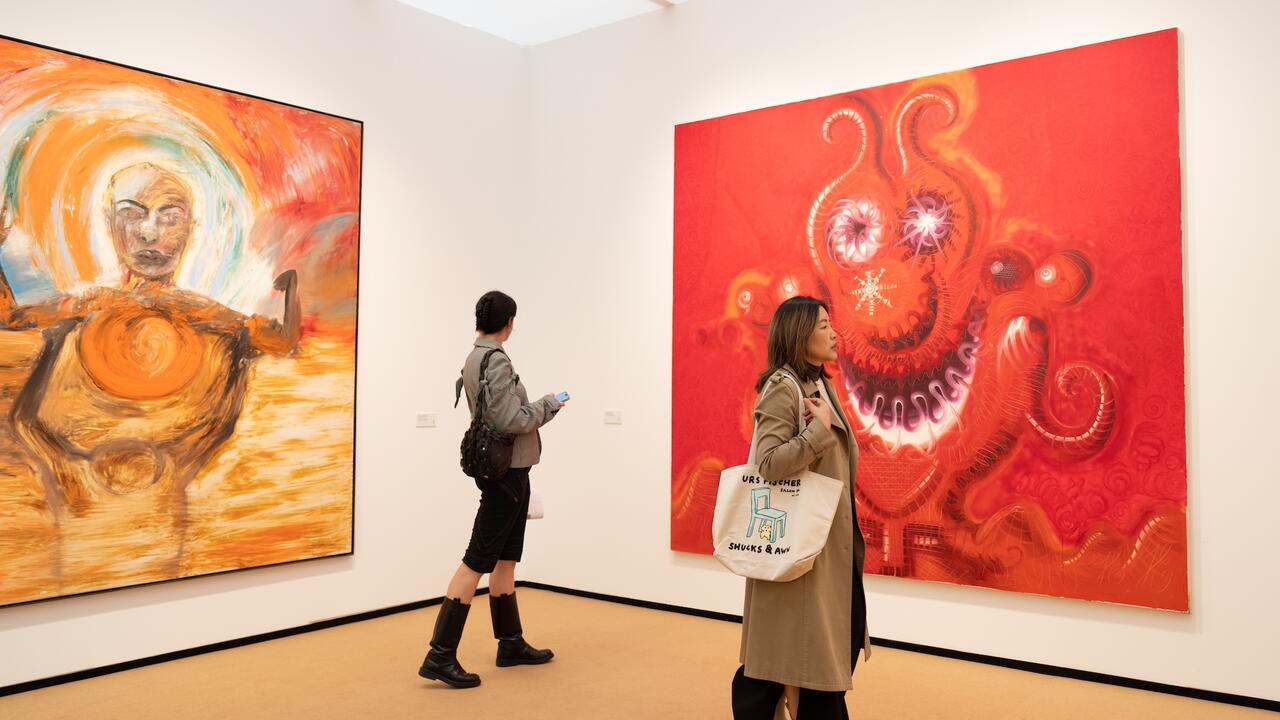Andreas Schulze
Sammlung Falckenberg, Hamburg and Sprüth Magers, Berlin, Germany
Sammlung Falckenberg, Hamburg and Sprüth Magers, Berlin, Germany

Andreas Schulze holds a unique position in painting. Even though his work was first shown with neo-expressionist painters in the 1980s, there was nothing gestural (let alone punk) about his approach. But his canvases weren’t as hard-edged and abstract as the Neo-Geo painters either. Schulze painted strange objects with round edges that made the harmlessness of petit-bourgeois interiors – cushions, doilies, lampshades – collide with the menace of amoeba- or tentacle-like forms. He has kept this visual vocabulary, while also expanding and varying it. One could mistake his work for being part of a 1980s dead-end of painting (the neo-surreal, faux naivety of the likes of Milan Kunc or Kenny Scharf). And there is something distinctly ’80s about Schulze’s work. But it’s more like an ’80s that never happened, in which Sigmar Polke took over Pee-Wee’s Playhouse, and made it both blander and more joyfully aggressive.
Even though painting remains Schulze’s prime medium, he also develops elaborate stagings of spaces. The artist brought that ‘playhouse’ aspect of his oeuvre to the fore in two back-to-back shows this summer: first a museum-size survey entitled ‘Interieur’ at Sammlung Falckenberg in Hamburg, then a small but effective show at Sprüth Magers in Berlin.
In Hamburg, he turned a central large space into a living-room wonderland of Gemütlichkeit and gentleness (Untitled, 2010): pieces of Schulze’s own design, such as a bulbous lampshade stuck on a colourful skirt-like cone base entitled Leuchte des Nordens (Bluse mit Rock) (Luminary of the North [Blouse with Skirt], 2004), were combined with pre-existing chairs ranging from Biedermeier to 1970s plastic. The floor was painted in a grassy green with grey paths, as if indicating tasks on a children’s board game one had to navigate like a sedated Pee-Wee Herman. There are usually white lines at the edges of Schulze’s colour planes, a light effect indicating the obsessive roundedness of objects just as in Disney animator Carl Barks’ drawings for Duckburg (though without the cuteness). A canvas hung in the space amplified this ominous lack of comfort amidst demonstrative comfiness: Untitled (Wohnzimmer) (Untitled [Living Room], 1986) shows yet another interior with a small chest of drawers; lines of round stones and worm-like forms look like a skeleton indicating the decay of what was once a sofa and a coffee table. Bambi’s head lurks from behind a linen-covered dining table, as if anxiously peering over the parapet of a trench.
One could think that Schulze’s main objective here was to reveal petit-bourgeois decoration as uncanny. But his affront is rather directed against the self-certitudes of the avant-gardes. Another painting hints at how exactly: Apfel (Apple, 1983) depicts an apple placed into the rectangular recess of a grey, concrete-like box filling the four-metre-wide and two-metre-high diptych. It’s as if a Donald Judd structure was quoted out of context in a vicious fairy tale. What turns form into taste? This seems the central question here, and Schulze’s answer tops Minimalist deadpan with quirky absurdism: in Sofa mit Weinberg (Rheinlandschaft bei Bacharach) (Sofa with Vineyard [Rhine Landscape near Bacharach], 2003), the painted postcard vista of a Romantic German wine region is half blocked by the frontal view onto a Postmodern red sofa with bombastic rosebud arms. As with Judd, illusory space is duped, yet with its own means.
In Berlin, Schulze applied his strategy of camouflage gormlessness to the entire framing of the show. Normally, before entering the upstairs exhibition space of Sprüth Magers, you have to pass a gallery assistant’s desk. Here it was removed, while large panoramic canvases of window views onto a garden decorated with absurdly trimmed forsythia hung across from the window frontage (Doppelfenster [Forsythie] and Panoramafenster [Forsythie], Double Window and Panorama Window, both 2010). The literalist joke was apparent, but its punchline was waiting in the ‘actual’ exhibition space. The work desk had been moved into it, surrounded by tourist posters of the Saxony region of Germany, inevitably turning the gallery assistant into an (in)voluntary tourist office assistant. But what was the attraction advertised? It occupied the centre of the space: a model-size, mock Dresden (Untitled [Dresden], 1997). Put together largely with miniature train utensils, it includes a mix of typical GDR-style prefab high-rises, generic post-1989 business architecture, as well as ruins of pre-war buildings. One of the latter is topped with a banner announcing ‘a Prada boutique soon to open here’. On top of a hill sits not a castle but a baroque Meissen tureen. While there are people and cars, conspicuously absent from the miniature-train cityscape are the moving trains: as if the town had been freeze-framed and removed from travel and social exchange.
Schulze keeps returning to the painting genres of interior and landscape, but he folds them in on each other. Similarly, he keeps returning to the 1980s, but not out of nostalgia: he uses the period as a sounding board echoing the silences and repressions of the ’50s, as well as forecasting the deceptive post-1989 freedom of taste.






















